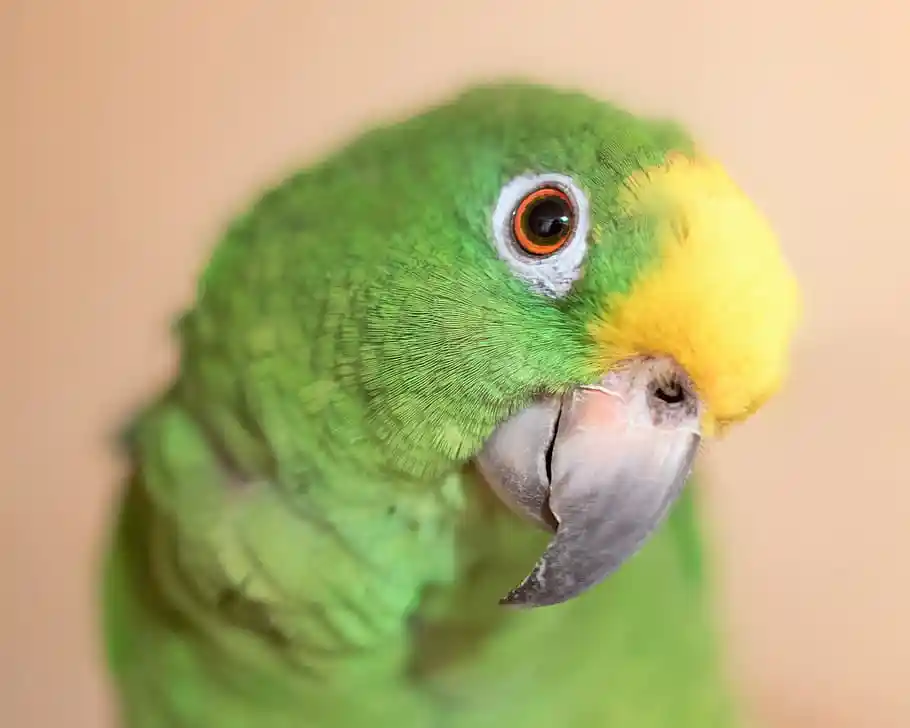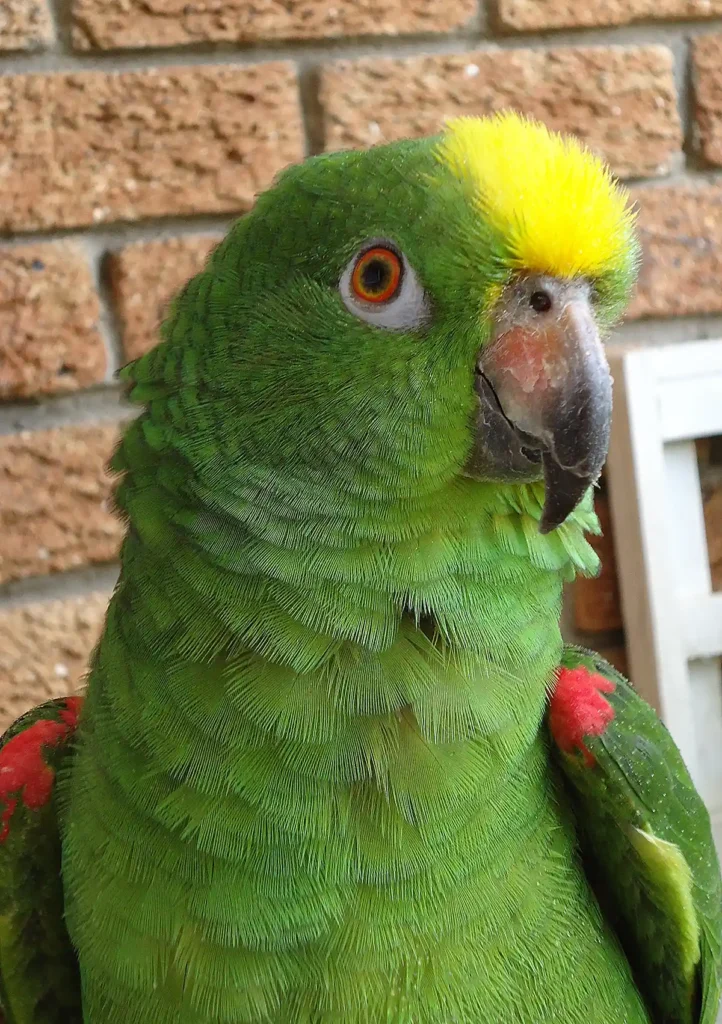
Imagine a bird with a crown of vibrant yellow feathers, a royal display in the animal kingdom. This isn’t a creature from a fairy tale, but a real bird that graces our world with its presence: the Yellow-crowned Amazon (Amazona ochrocephala). This article will provide an in-depth look at the Yellow-crowned Amazon, from its habitat and diet to its behavior and care. So, are you ready to embark on a journey to the heart of the Amazon and meet this magnificent bird?
Brief Overview
The Yellow-crowned Amazon, also known as the Yellow-crowned parrot, is a member of the Amazona family, a diverse group of parrots renowned for their intelligence and beauty. These birds, with their distinctive yellow crown, are native to the tropical regions of Central and South America, specifically from Brazil and Venezuela to the Guianas and up to Honduras and Costa Rica.
The Yellow-crowned Amazon belongs to the oratrix group, one of three main groups of Amazons. The other two groups are the auropalliata group and the Amazona a group. Each of these groups has its unique characteristics, but the Yellow-crowned Amazon is one of the most captivating of all.

Physical Characteristics
The Yellow-crowned Amazon is a medium-sized parrot, robust and full-bodied. Its most striking feature, which gives the bird its name, is the vibrant yellow patch on its crown.
It’s part of the larger family of Amazon parrots. These parrots are known for their impressive size, with body lengths often ranging from 13 to 18 inches. They have robust bodies and strong legs. Their bills are well-adapted for cracking seeds, one of their primary food sources.
Color and Markings
The Yellow-crowned Amazon’s plumage is primarily green, providing perfect camouflage in its native forests. But the colorful highlights truly make this bird a spectacle. The crown region, adorned with yellow feathers (hence the name), stands out against the green plumage. A hint of red is seen on the bend of the wing, and the tail showcases beautiful rainbow markings.
The beak, or mandible, is horn-colored, and the eyes, or iris, are orange. The nape and cheeks might show bluish hues. The tail is predominantly green, but the tail feathers often have violet-blue tips. A unique feature of these parrots is their wing speculum, a patch of bright feathers on the upper wing surface that is visible in flight.
Size and Weight
These birds measure approximately 35-43 cm (13-18 in) in length, and their wingspan can reach up to 20 cm (8 in). They typically weigh between 450-550 grams.
Subspecies
Several subspecies of Amazona ochrocephala have been identified, including Amazona o. nattereri, Amazona o. panamensis, and Amazona o. auropalliata. These subspecies, along with others like Amazona o. belizensis and Amazona o. xantholaema, show variation in their physical characteristics and geographical range. For instance, Amazona o. nattereri, found in the Mato Grosso region of Brazil, has a more pronounced yellow head and red shoulders.

Differences with other species
The Yellow-crowned Amazon, Yellow-naped Amazon (Amazona auropalliata), and the Yellow-headed Amazon (Amazona oratrix) are easy to confused, but each species has features that make it different from the others. The Yellow-crowned Amazon showcases a vibrant yellow crown, contrasted against its predominantly green body and blue-tipped wings. The Yellow-naped Amazon, on the other hand, sports a distinctive yellow patch on the back of its neck, setting it apart from its otherwise green plumage. The Yellow-headed Amazon is the most dramatic of the three, with a bold yellow head and specks of red and blue adorning its wings and tail. Despite their differences, each parrot exudes a captivating beauty that appeals to bird enthusiasts around the world.
Habitat and Distribution
The Yellow-crowned Amazon has a wide range, with subspecies found from Central America to South America. The Amazona o. panamensis, for example, can be seen from western Panama to Honduras. Their habitats are as varied as their distribution, ranging from mangroves and woodlands to savannas.
The Yellow-crowned Amazon parrot thrives in a variety of habitats, including mangroves, woodland, and savanna, from the lowland bird areas to the slopes of South America. They can be found in countries like Brazil, Colombia, Ecuador, Peru, Bolivia, Suriname, Guyana and French Guiana, extending even to the Amazon River region. They even inhabit island populations in Trinidad. Some subspecies, like Amazona o. nattereri, are found in specific regions only, like Mato Grosso in Brazil.

Diet and Nutrition
In the wild, the Yellow-crowned Amazon feeds on a variety of foods, including seeds, fruits, and leaf buds. They’ve even been known to enjoy flowers. In captivity, owners should provide a balanced diet of vegetables, fruits, and bird-safe nuts, in addition to a high-quality parrot pellet mix.
Fresh water should always be readily available. Care should be taken not to overfeed these birds, as they can be prone to weight gain. Some favorite fruits and vegetables include apple, pear, banana, pomegranate, carrot, beans, and celery.
Behavior and Communication
These parrots are social animals, often found in pairs or flocks. They communicate through a variety of calls and sounds, which can be quite loud at times. Their ability to mimic the human voice and other sounds has made them popular pets.
Their behavior includes preening, flying, foraging, and socializing. These birds are known for their playful personalities, often seen swinging from branches or playing with toys. They also exhibit a fascinating flight pattern, with swift wing beats followed by a glide.

Lifespan
The Yellow-crowned Amazon parrot has a notable longevity. In the wild, they can live for about 60 to 80 years, while in captivity, with proper care, they can live even longer. This lifespan makes them a long-term commitment for any pet owners.
These birds can develop a deep bond with their human caretakers, often seen through their playful interactions and mimicking behaviors. They may become distressed if they don’t receive enough attention, making social interaction an essential part of their care.
Breeding and Reproduction
Breeding season for Yellow-crowned Amazons usually happens once a year. The female typically lays a clutch of two to three eggs, which both parents share the responsibility of incubating. After about 26 to 28 days, the chicks hatch, and they leave the nest after about 60 days.
Health and Care
Yellow-crowned Amazons require regular care to stay healthy. This includes a balanced diet, regular exercise, and mental stimulation. They also enjoy perches and toys in their aviary or cage. Regular vet check-ups are crucial to monitor their health and diagnose any potential health issues like obesity or vitamin deficiencies.
When it comes to sexing Yellow-crowned Amazons, it can be challenging to distinguish males from females based on physical characteristics alone as both sexes have similar plumage. DNA testing or surgical sexing is often used for accurate determination.
The Yellow-crowned Amazon Parrot as a Pet
The Yellow-crowned Amazon Parrot can make an excellent pet bird for the right person. They are intelligent, social, and lively. However, they do require a lot of attention and mental stimulation.
Potential owners should also be aware of their loud calls, which may not be suitable for all living situations. However, their ability to mimic human voices and their playful personalities more than make up for their volume.

Conservation Status and Threats
The Yellow-crowned Amazon is currently listed as “Least Concern” by IUCN and BirdLife International, but their populations are declining. Habitat destruction, particularly in the Amazon Basin, and the pet trade pose significant threats to these birds.
In the wild, these parrots roost in trees, often in large flocks. They feed and socialize during the day, and at night, they return to their roosts. Their calls can be heard echoing through the woodlands, savannas, and rainforests they inhabit.
Despite their wide distribution, Yellow-crowned Amazon parrot populations are under threat due to habitat loss and illegal pet trade. Conservation efforts are in place to protect these beautiful birds, focusing on habitat preservation and regulation of the pet trade.
Role in the Ecosystem
As seed eaters, Yellow-crowned Amazons play a vital role in their ecosystems as seed dispersers. They consume various fruits, carrying the seeds away from the parent plant, and contribute to the diversity and spread of plant species in their habitats.
Whether seen flying over the rainforests of Central America, the woodlands of South America, or living as beloved pets in human homes, the Yellow-crowned Amazon parrot continues to captivate with its vibrant colors, dynamic behaviors, and fascinating social structures.

Conclusion
The Yellow-crowned Amazon is a stunning bird with a rich history and complex behavior. Their vibrant colors, intelligence, and captivating personalities make them a beloved species among bird enthusiasts. Despite the challenges they face, these birds continue to thrive, adding a splash of color and a chorus of calls to the forests of Central and South America.
